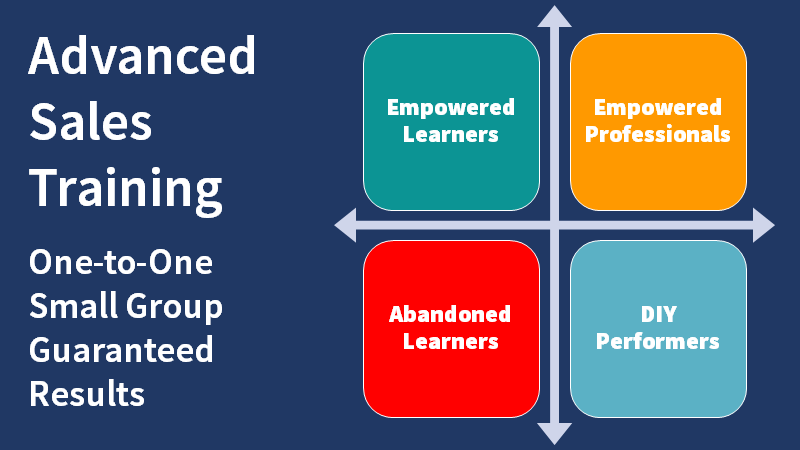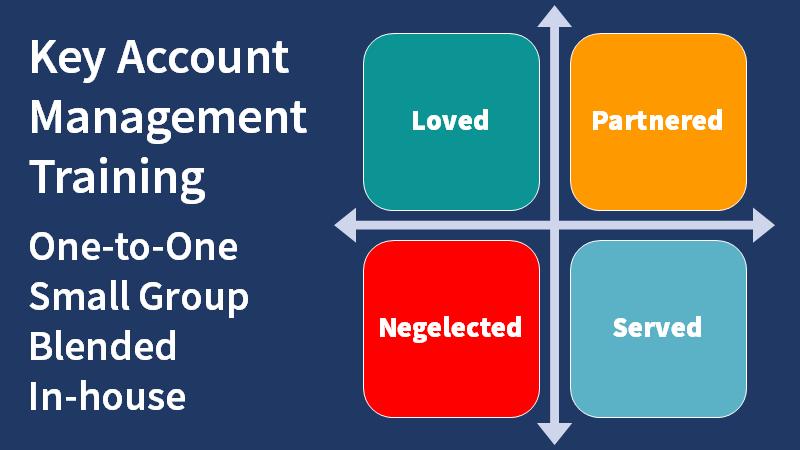Sales pipeline management training - improve sales forecasting and qualification while increasing results.

Develop rigour in sales forecasting and qualification. Improve pipeline management, business predictability, and success rates.
How is this course different from others?
- The opportunity to use upside-down learning. We provide access to the course content in advance of training sessions.
- In-session learning time can be spent testing principles through exercises, planning implementation, and preparing workplace actions.
- The opportunity for one-to-one learning.
- Facilitation and delivery by the course author.
Time spent speaking to sales prospects who don't buy, or buy from competitors is wasted.
Improve sales forecasting, business predictability, and sales results. Learn how to thin out fat pipes so that effort is focused on those prospects who will buy, opportunities that can be won, and sales that will be worthwhile.
Key 'how to' Takeaways
- Identify the right prospects.
- Discard poor prospects early.
- Know if you can win before committing.
- Know what to do next.
- Maintain a rich flow of suspects.
- Keep the sales pipeline moving.
- Increase sales predictability.
- Improve conversion rate.
- Sell what you say you will.
Course Content
Introduction: Goals, objectives, and learning management
Only Sell to Hungry People: How to focus on the right opportunities.
Quantified Qualification: Will it happen, can you win, and will it be worthwhile?
Pipeline Mechanics: Always having enough worthwhile opportunities.
Buying Process: Understanding the stages in the customer's buying process.
Sales Process: Aligning the sales process with the customer's buying process.
Target Achievement: Using a plan to drive performance.
Review and Next Steps: How to transform learning into results.
Programme includes:
- Pre-course questionnaire.
- Pre-work preparation guide.
- Personalised workplace assignments.
- Programme slide decks, tools, and materials.
- Online resources.
- Career-long support.
Materials and resources
- Self-study notes.
- Accelerated learning guide.
- Prospect profiling tool.
- Quantified qualification assessment.
- Sales stage identifier.
- Sales pipeline management report.
- Sales forecast presentation template.
Sales Pipeline Management Training Delivery Options
One-to-One:
Eight 1-hour or four 2-hour virtual classroom sessions delivered by the course author.
£995 - Learn more.
One-to-one on a per-session basis:
£150 per 1-hour session - Learn more.
Via Virtual Classroom Group Training:
Eight 1-hour or four 2-hour virtual classroom sessions delivered by the course author.
£3195 for up to fifteen people - Learn more.
Selected content on a per-session basis:
£450 per 1-hour session. Learn more.
Fees exclude applicable VAT.
Traditional Classroom
Delivery over one or more days at a conference venue or the customer's offices. Contact us for fees.
What are the best practices for accurate B2B sales forecasting?
Accurate business-to-business (B2B) sales forecasting is essential for effective planning, resource allocation, and decision-making. Here are best practices for achieving accuracy in B2B sales forecasting:
1. Use Historical Data as a Foundation
Analyse past sales trends, seasonality, and patterns. Focus on reliable and clean data from your CRM or sales management tools. Account for anomalies, such as one-time deals or unusual market conditions, that might skew the data.
2. Segment Your Forecast
Break down forecasts by region, product line, sales team, or client type for more granularity. Use segmentation to identify specific factors impacting different areas of the business.
3. Incorporate Pipeline Data
Leverage sales pipeline data to assess the likelihood of closing deals based on their stage. Use weighted probability models to estimate revenue contributions from deals at different stages.
4. Engage Your Sales Team
Collect input from your sales team or peers to understand nuances like client intent or competitor activity. Establish consistency in how CRM data is updated and managed.
5. Monitor Market and Economic Conditions
Stay informed about industry trends, macroeconomic factors, and competitive dynamics. Adjust forecasts for external factors such as regulatory changes or supply chain disruptions.
6. Account for Sales Cycle Length
Consider the typical duration of your sales cycle, especially in B2B, where cycles can be long and complex. Adjust forecasts to reflect where deals are in the sales journey.
7. Set Clear Metrics and KPIs
Define metrics like lead conversion rate, average deal size, and sales velocity. Track and analyse these KPIs to validate and refine your forecasting model.
8. Continuously Review and Adjust
Regularly compare forecasts with actual outcomes to identify and correct inaccuracies. Adjust models based on performance reviews and new insights. Schedule periodic updates (e.g., weekly or monthly) to reflect real-time changes in the pipeline or market.
9. Consult with Related Functions
Take into account inputs from marketing, operations, and finance teams. Ensure shared understanding of goals, assumptions, and external influences.
By combining data-driven methods with informed judgment and regular reviews, B2B organisations can create reliable forecasts that adapt to changing conditions and support strategic decisions.
Guarantee
We unconditionally guarantee the quality and effectiveness of our services. In addition, we warrant that applying the principles, methods, and practices presented in our materials will lead to a gain in value equivalent to at least five times the fees. Should you decide that our services have not met this guarantee, we will refund your fees promptly and courteously.
Note: Quoted fees exclude UK VAT.
If you are looking for sales pipeline management training or need to improve sales forecasting, we can help. Telephone +44 (0)1392 851500 for more information. We will be pleased to learn about your needs or discuss some options. Alternatively, email custserv@salessense.co.uk or use the contact form here.






















